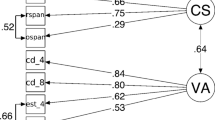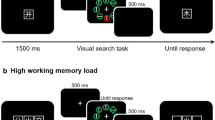Abstract
Castel and colleagues (Percept Psychophys 65(6):970–981, 2003) proposed that visuospatial working memory is needed to retain and update the irrelevant but attended location in an inhibition of return (IOR) procedure. In a series of three experiments, we re-examined this hypothesis by loading visuospatial working memory and manipulating the timing of encoding. When the visuospatial memory items were presented right after the cue, as in Castel et al. (Percept Psychophys 65(6):970–981, 2003), we replicated the lack of IOR in the dual-task condition (Experiment 1). However, when we presented the visuospatial memory items before the spatial cue, to control for retroactive interference in encoding, we found robust IOR effects (Experiment 2); the effect remained strong even when participants were prevented from using verbal labels to rehearse the memory material (Experiment 3). We conclude that IOR does not seem to depend on retaining the position of the irrelevant cue in visuospatial working memory.


Similar content being viewed by others
Notes
We would like to thank Dr R. Logie for this suggestion.
We would like to thank Dr R. Logie for pointing out this limitation.
Notice that the interval between the cue and the first memory object in Experiment 1a and in Castel et al.’s study (2003) was zero.
References
Andrade, J., Kemps, E., Werniers, Y., May, J., & Szmalec, A. (2002). Insensitivity of visual short-term memory to irrelevant visual information. The Quarterly Journal of Experimental Psychology, 55A, 753–774.
Baddeley, A. D., Lewis, V., & Vallar, G. (1984). Exploring the articulatory loop. Quarterly Journal of Experimental Psychology: Human Experimental Psychology, 36A, 233–252.
Berlucchi, G. (2006). Inhibition of return: a phenomenon in search of a mechanism and a better name. Cognitive Neuropsychology, 23(7), 1065–1074.
Castel, A. D., Pratt, J., & Craik, F. I. (2003). The role of spatial working memory in inhibition of return: evidence from divided attention tasks. Perception and Psychophysics, 65(6), 970–981.
Colby, C. L., & Golberg, M. E. (1999). Space and attention in parietal cortex. Annual Review of Neuroscience, 23, 319–349.
Danziger, S., Kingstone, A., & Snyder, J. J. (1998). Inhibition of return to successively stimulated locations in a sequential visual search paradigm. Journal of Experimental Psychology: Human Perception and Performance, 24, 1467–1475.
Gottlieb, J. P., Kusunoki, M., & Goldberg, M. E. (1998). The representation of visual salience in monkey parietal cortex. Nature, 391, 481–484.
Heinke, D., & Humphreys, G. W. (2003). Attention, spatial representation and visual neglect: simulating emergent attentional processes in the selective attention for identification model (SAIM). Psychological Review, 110, 29–87.
Itti, L., & Koch, C. (2001). Computational modeling of visual attention. Nature Reviews Neuroscience, 2, 1994–2003.
Jonides, J., & Irwin, D. E. (1981). Capturing attention. Cognition, 10(1–3), 145–150.
Klein, R. M. (1988). Inhibitory tagging system facilitates visual search. Nature, 334, 430–431.
Klein, R. M., Castel, A., & Pratt, J. (2006). The effect of memory load on the time course of inhibition of return. Psychonomic Bulletin & Review, 13(2), 294–299.
Koch, C., & Ullman, S. (1985). Shifts in selective visual attention: towards the underlying neural circuitry. Human Neurobiology, 4, 219–227.
Logie, R. H., Zucco, G. M., & Baddeley, A. D. (1990). Interference with visual short-term memory. Acta Psychologica (Amst), 75(1), 55–74.
Makovski, T., Shim, W. M., & Jiang, Y. V. (2006). Interference from filled delays on visual change detection. Journal of Vision, 6, 1459–1470.
Posner, M. I., & Cohen, Y. (1984). Components of visual orienting. In H. Bouma & D. Bouwhuis (Eds.), Attention and performance X (pp. 531–556). Hove: Lawrence Erlbaum.
Posner, M. I., Rafal, R. D., Choate, L. S., & Vaughn, J. (1985). Inhibition of return: neural basis and function. Cognitive Neuropsychology, 2, 211–228.
Quinn, J. G., & McConnell, J. (2006). The interval for interference in conscious visual imagery. Memory, 14(2), 241–252.
Roediger, H. L. (1990). Implicit memory: retention without remembering. American Psychologist, 45, 1043–1056.
Santangelo, V., Belardinelli, M. O., & Spence, C. (2007). The supression of reflective visual and auditory orienting when attention is otherwise engaged. Journal of Experimental Psychology: Human Perception and Performance, 33(1), 137–148.
Santangelo, V., Ho, C., & Spence, C. (2008). Capturing spatial attention with multisensory cues. Psychonomic Bulletin & Review, 15(2), 398–403.
Santangelo, V., & Spence, C. (2008). Is the exogenous orienting of spatial attention truly automatic? Evidence from unimodal and multisensory studies. Consciousness and Cognition, 17, 989–1015.
Shipp, S. (2004). The brain circuitry of attention. Trends in Cognitive Science, 8, 223–230.
Shore, D. I., & Klein, R. M. (2000). On the manifestations of memory in visual search. Spatial Vision, 14, 59–75.
Snyder, J. J., & Kingstone, A. (2000). Inhibition of return and visual search: how many separate loci are inhibited? Perception & Psychophysics, 62, 452–458.
Tipper, S. P., Grison, S., & Kessler, K. (2003). Long-term inhibition of return of attention. Psychological Science, 14(1), 19–25.
Tipper, S. P., Weaver, B., & Watson, F. (1996). Inhibition of return to successively cued spatial locations: a commentary on Pratt and Abrams (1995). Journal of Experimental Psychology: Human Perception and Performance, 22, 1290–1293.
Vivas, A. B., Humphreys, G. W., & Fuentes, L. J. (2003). Inhibitory processing following damage to the parietal lobe. Neuropsychologia, 41, 1531–1540.
Vivas, A. B., Humphreys, G. W., & Fuentes, L. J. (2006). Abnormal inhibition of return: a review and new data on patients with parietal lobe damage. Cognitive Neuropsychology, 23, 1049–1064.
Vivas, A. B., Humphreys, G. W., & Fuentes, L. J. (2008). Object-based inhibition of return in patients with posterior parietal damage. Neuropsychology, 22(2), 169–176.
Wolfe, J. M. (1994). Visual search in continuous naturalistic stimuli. Vision Research, 34(9), 1187–1195.
Woodman, G. F., Vogel, E. K., & Luck, S. J. (2001). Visual search remains efficient when visual working memory is full. Psychological Science, 12, 219–224.
Acknowledgments
We would like to thank Georgia Liontou for the assistance in collecting data. Also, we are grateful to Dr Robert Logie, Dr Juan Lupiañez and Dr Bernhard Hommel for their comments on previous versions of this manuscript.
Author information
Authors and Affiliations
Corresponding author
Rights and permissions
About this article
Cite this article
Vivas, A.B., Liaromati, I., Masoura, E. et al. Re-examining the contribution of visuospatial working memory to inhibition of return. Psychological Research 74, 524–531 (2010). https://doi.org/10.1007/s00426-010-0274-7
Received:
Accepted:
Published:
Issue Date:
DOI: https://doi.org/10.1007/s00426-010-0274-7




